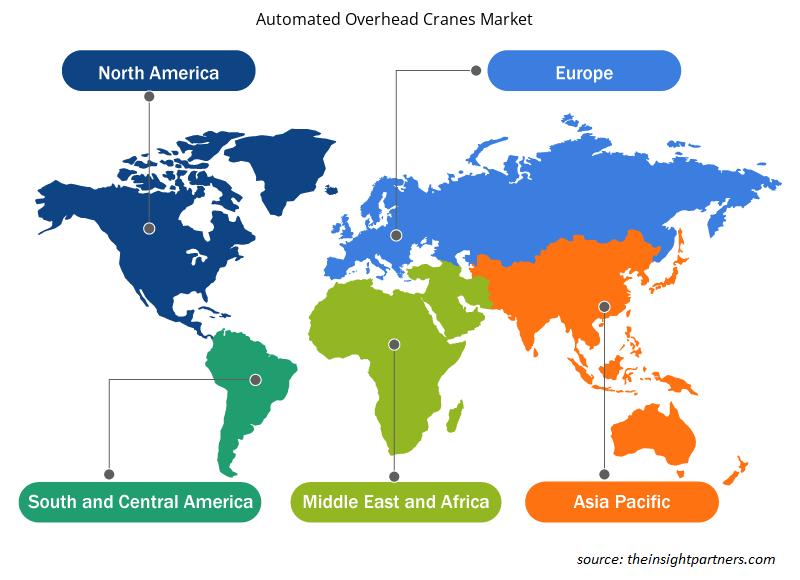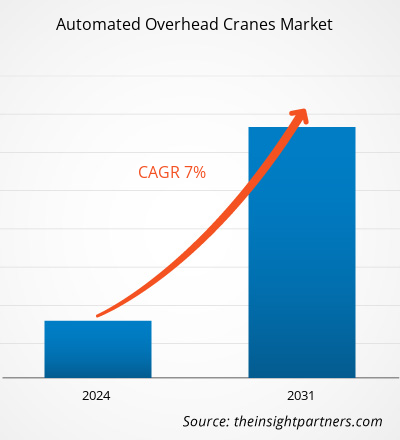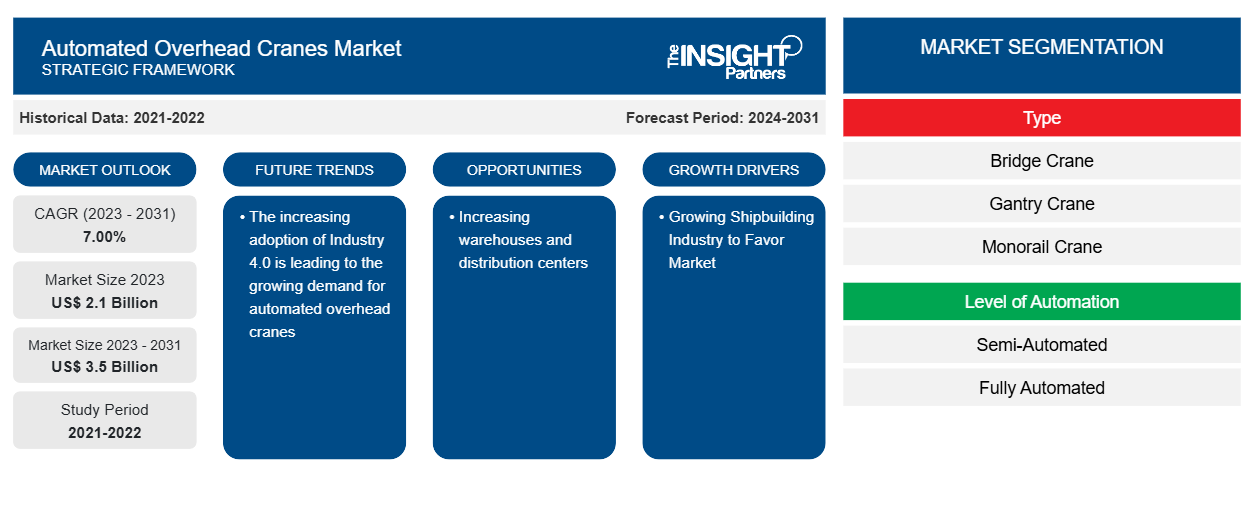Der Markt für automatisierte Brückenkräne soll von 2,1 Milliarden US-Dollar im Jahr 2023 auf 3,5 Milliarden US-Dollar im Jahr 2031 anwachsen. Der Markt soll zwischen 2023 und 2031 eine durchschnittliche jährliche Wachstumsrate (CAGR) von 7,00 % verzeichnen. Die zunehmende Einführung von Industrie 4.0 führt zu einer steigenden Nachfrage nach automatisierten Brückenkränen. Diese Kräne werden außerdem mit intelligenter Technologie ausgestattet, die aufschlussreiche Daten liefert, die den effektiven Betrieb der Industrie 4.0-Technologie weiter unterstützen. Diese Einführung von Industrie 4.0 wird wahrscheinlich ein wichtiger Trend auf dem Markt bleiben.
Marktanalyse für automatisierte Brückenkräne
Zu den Beteiligten am Markt für automatisierte Brückenkräne gehören Lieferanten von Komponenten für automatisierte Brückenkräne, Hersteller von automatisierten Brückenkränen und Endnutzer. Die Präsenz einer großen Anzahl von Komponentenlieferanten, darunter Laufkatzenrahmen , Drähte/Seile, Brückenräder, Hebezeuge, Laufschienen und andere Hersteller, erleichtert es den Herstellern automatisierter Brückenkräne, die Anforderungen ihrer jeweiligen Kunden zu erfüllen. Lieferanten von Komponenten für automatisierte Brückenkräne steigern ihre Produktionskapazitäten, um der wachsenden Nachfrage nach Herstellern automatisierter Brückenkräne gerecht zu werden. Da die Hersteller automatisierter Brückenkräne kontinuierlich mit Komponentenlieferanten und Endnutzern zusammenarbeiten, hilft ihnen dies, die Anforderungen der Endnutzer zu verstehen und fortschrittliche Komponenten zu entwickeln. Sie haben auch verschiedene Vertriebshändler in verschiedenen Ländern und Regionen, die den Endnutzern ebenfalls Serviceunterstützung bieten.
Marktübersicht für automatisierte Brückenkräne
Aufgrund ihrer Budgetbeschränkungen sind die Akteure der Branche recht skeptisch, wenn es darum geht, in fortschrittliche automatisierte Lösungen zu investieren, die hohe anfängliche Investitionskosten und später Kosten für ständige Upgrades und Wartung mit sich bringen. Die Branchen, die automatisierte Brückenkräne einführen, benötigen im Voraus gut ausgebildete und sachkundige Lösungsanbieter, die die Feinheiten ihrer Implementierungen kennen, wie etwa die Kosten für die Herstellung und Erneuerung des automatisierten Brückenkrans, Wartung, Servicegebühren, Schulung und Beratung usw. Da diese für ein Unternehmen äußerst wichtig sind, kann selbst ein kleiner Mangel erhebliche finanzielle Auswirkungen haben. Darüber hinaus schränken die Eigentümer kleiner und mittlerer Unternehmen in verschiedenen Branchen aufgrund ihres begrenzten Budgets für Industriemaschinen weiterhin das Marktwachstum ein . Darüber hinaus wird erwartet, dass der preissensible Markt, wie beispielsweise bestimmte Länder in Asien und Afrika, die Einführung automatisierter Brückenkräne aufgrund von Budgetproblemen und mangelndem Bewusstsein des Industriepersonals negativ beeinflussen wird. Dies behindert das Wachstum des Marktes für automatisierte Brückenkräne weltweit.
Passen Sie diesen Bericht Ihren Anforderungen an
Sie erhalten kostenlos individuelle Anpassungen an jedem Bericht, einschließlich Teilen dieses Berichts oder einer Analyse auf Länderebene, eines Excel-Datenpakets sowie tolle Angebote und Rabatte für Start-ups und Universitäten.
-
Holen Sie sich die wichtigsten Markttrends aus diesem Bericht.Dieses KOSTENLOSE Beispiel umfasst eine Datenanalyse von Markttrends bis hin zu Schätzungen und Prognosen.
Markttreiber und Chancen für automatisierte Brückenkräne
Wachsende Schiffbauindustrie begünstigt Markt
Die Schiffbauindustrie wächst aufgrund des zunehmenden Seetransports. Laut den von der National Oceanic and Atmospheric Administration im Jahr 2023 veröffentlichten Daten verzeichnete der Schiffs- und Bootsbau seit 2020 eine Wachstumsrate von 15 %. Darüber hinaus hat Chinas Schiffs- und Bootsbauindustrie die Auslieferung von 38 Millionen Tonnen an Schiffen und Booten abgeschlossen, ein Wachstum von 12 % seit 2022. Ein solcher Anstieg in der Schiffs- und Bootsbauindustrie führt zu einer erhöhten Nachfrage nach automatisierten Brückenkränen, was letztlich den Markt antreibt.
Ausbau der Lagerhallen und Distributionszentren
Die E-Einzelhändler freuen sich jetzt stärker darauf, Lager in Städten der Stufe II und III zu eröffnen. Daher wird die Nachfrage nach automatisierten Brückenkränen in Lagern und Vertriebszentren zum Heben schwerer Geräte und zur Materialhandhabung steigen. Der Lagerkran besteht normalerweise aus einem Einträger-Brückenkran, einem Zweiträger-Brückenkran und einem elektrischen Hubportalkran für Hebezwecke. Die meisten Lager und Vertriebszentren verwenden automatisierte Brückenkräne mit einer Tragfähigkeit von 1, 3, 5 und 10 bis 100 Tonnen.lll cities. Thus, the demand for automated overhead cranes across warehouses and distribution centers for lifting heavy equipment and material handling will increase. The warehouse crane usually consists of a single-girder overhead crane, a double-girder overhead crane, and an electric hoist gantry crane for lifting purposes. The majority of the warehouses and distribution centers use automated overhead cranes with a lifting capacity of 1 ton, 3 ton, 5 ton, and 10 ton up to 100 tons.
Segmentierungsanalyse des Marktberichts für automatisierte Brückenkräne
Wichtige Segmente, die zur Ableitung der Marktanalyse für automatisierte Brückenkräne beigetragen haben, sind Typ, Automatisierungsgrad und Branche.
- Nach Typ ist der Markt für automatisierte Brückenkräne in Brückenkräne, Portalkräne, Einschienenbahnkräne, Auslegerkräne und andere unterteilt. Das Segment der Brückenkräne hatte im Jahr 2023 einen größeren Marktanteil.
- Nach Automatisierungsgrad ist der Markt in halbautomatisch und vollautomatisch segmentiert. Das halbautomatische Segment hielt im Jahr 2023 den größten Marktanteil.
- Branchenbezogen ist der Markt in Fertigung, Schiffbau, Metall- und Stahlbau und Sonstige unterteilt. Das Fertigungssegment hielt im Jahr 2023 einen erheblichen Marktanteil.
Automatisierte Brückenkräne Marktanteilsanalyse nach Geografie
Der geografische Umfang des Marktberichts zu automatisierten Brückenkränen ist hauptsächlich in fünf Regionen unterteilt: Nordamerika, Asien-Pazifik, Europa, Naher Osten und Afrika sowie Süd- und Mittelamerika.
Der asiatisch-pazifische Raum dominierte den globalen Markt für automatisierte Brückenkräne. Europa hatte den zweitgrößten Marktanteil. China hat sich zu einem der Produktionszentren weltweit entwickelt. So ist das Land zu einem der bedeutendsten Anbieter kostengünstiger Ausrüstung geworden. Darüber hinaus hat die Schiffbauindustrie in den letzten Jahren ein starkes Wachstum erlebt, was dem Markt weitere lukrative Möglichkeiten bietet.
Regionale Einblicke in den Markt für automatisierte Brückenkräne
Die regionalen Trends und Faktoren, die den Markt für automatisierte Brückenkräne während des gesamten Prognosezeitraums beeinflussen, wurden von den Analysten von Insight Partners ausführlich erläutert. In diesem Abschnitt werden auch die Marktsegmente und die Geografie für automatisierte Brückenkräne in Nordamerika, Europa, im asiatisch-pazifischen Raum, im Nahen Osten und Afrika sowie in Süd- und Mittelamerika erörtert.

- Erhalten Sie regionalspezifische Daten zum Markt für automatisierte Brückenkräne
Umfang des Marktberichts über automatisierte Brückenkräne
| Berichtsattribut | Details |
|---|---|
| Marktgröße im Jahr 2023 | 2,1 Milliarden US-Dollar |
| Marktgröße bis 2031 | 3,5 Milliarden US-Dollar |
| Globale CAGR (2023 - 2031) | 7,00 % |
| Historische Daten | 2021-2022 |
| Prognosezeitraum | 2024–2031 |
| Abgedeckte Segmente |
Nach Typ
|
| Abgedeckte Regionen und Länder |
Nordamerika
|
| Marktführer und wichtige Unternehmensprofile |
|
Marktteilnehmerdichte: Der Einfluss auf die Geschäftsdynamik
Der Markt für automatisierte Brückenkräne wächst rasant, angetrieben durch die steigende Nachfrage der Endnutzer aufgrund von Faktoren wie sich entwickelnden Verbraucherpräferenzen, technologischen Fortschritten und einem größeren Bewusstsein für die Vorteile des Produkts. Mit steigender Nachfrage erweitern Unternehmen ihr Angebot, entwickeln Innovationen, um die Bedürfnisse der Verbraucher zu erfüllen, und nutzen neue Trends, was das Marktwachstum weiter ankurbelt.
Die Marktteilnehmerdichte bezieht sich auf die Verteilung der Firmen oder Unternehmen, die in einem bestimmten Markt oder einer bestimmten Branche tätig sind. Sie gibt an, wie viele Wettbewerber (Marktteilnehmer) in einem bestimmten Marktraum im Verhältnis zu seiner Größe oder seinem gesamten Marktwert präsent sind.
Die wichtigsten auf dem Markt für automatisierte Brückenkräne tätigen Unternehmen sind:
- Automatische Systeme
- Avon Barrier Corporation Ltd
- CAME SpA
- Houston System Inc.
- LA BARRIÈRE AUTOMATIQUE
- MACS Automatische Pollersysteme
Haftungsausschluss : Die oben aufgeführten Unternehmen sind nicht in einer bestimmten Reihenfolge aufgeführt.

- Erhalten Sie einen Überblick über die wichtigsten Akteure auf dem Markt für automatisierte Brückenkräne
Marktnachrichten und aktuelle Entwicklungen zu automatisierten Brückenkränen
Der Markt für automatisierte Brückenkräne wird durch die Erfassung qualitativer und quantitativer Daten nach Primär- und Sekundärforschung bewertet, die wichtige Unternehmensveröffentlichungen, Verbandsdaten und Datenbanken umfasst. Einige der Entwicklungen auf dem Markt für automatisierte Brückenkräne sind unten aufgeführt:
- EMH hat Portalkräne mit halben Beinen auf den Markt gebracht. Diese Kräne sind für den Materialtransport zwischen den Arbeitsplätzen konzipiert. (Quelle: EMH, Newsletter, September 2023)
Marktbericht zu automatisierten Brückenkränen – Abdeckung und Ergebnisse
Der Bericht „Marktgröße und Prognose für automatisierte Brückenkräne (2021–2031)“ bietet eine detaillierte Analyse des Marktes, die die folgenden Bereiche abdeckt:
- Marktgröße und Prognose für automatisierte Brückenkräne auf globaler, regionaler und Länderebene für alle wichtigen Marktsegmente, die im Rahmen des Projekts abgedeckt sind
- Markttrends für automatisierte Brückenkräne sowie Marktdynamik wie Treiber, Einschränkungen und wichtige Chancen
- Detaillierte Porter's Five Forces und SWOT-Analyse
- Marktanalyse für automatisierte Brückenkräne mit wichtigen Markttrends, globalen und regionalen Rahmenbedingungen, wichtigen Akteuren, Vorschriften und aktuellen Marktentwicklungen
- Branchenlandschaft und Wettbewerbsanalyse, die die Marktkonzentration, Heatmap-Analyse, prominente Akteure und aktuelle Entwicklungen für den Markt für automatisierte Brückenkräne umfasst
- Detaillierte Firmenprofile
- Historische Analyse (2 Jahre), Basisjahr, Prognose (7 Jahre) mit CAGR
- PEST- und SWOT-Analyse
- Marktgröße Wert/Volumen – Global, Regional, Land
- Branchen- und Wettbewerbslandschaft
- Excel-Datensatz
Aktuelle Berichte
Erfahrungsberichte
Grund zum Kauf
- Fundierte Entscheidungsfindung
- Marktdynamik verstehen
- Wettbewerbsanalyse
- Kundeneinblicke
- Marktprognosen
- Risikominimierung
- Strategische Planung
- Investitionsbegründung
- Identifizierung neuer Märkte
- Verbesserung von Marketingstrategien
- Steigerung der Betriebseffizienz
- Anpassung an regulatorische Trends























 Kostenlose Probe anfordern für - Markt für automatisierte Brückenkräne
Kostenlose Probe anfordern für - Markt für automatisierte Brückenkräne